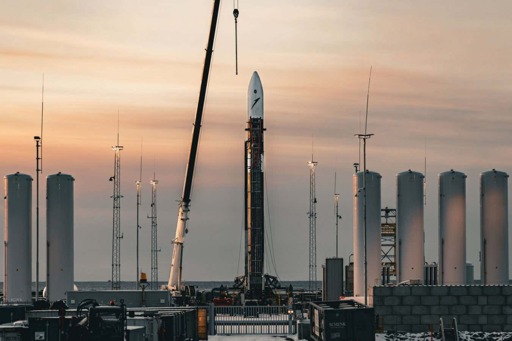Preparations are under way for a rocket test flight in Norway that could make history and give Europe greater independence from the market leader in orbital launches, the United States.
Isar Aerospace says it is planning to launch on 24 March between 12.30pm and 3.30pm CET, weather permitting.
I am so excited. It feels like my country is finally moving and doing something. After being dormant for decades. Yay!
The sleeper (Europe as a whole) must awaken!
I think it finally has. For the first time ever, I feel like Europe is actually doing something. It’s awesome.
*For the first time in 80 years…
We know how to do stuff, it’s just that we thought the world a friendlier place.
I think we are on the same page tho. Let’s not get pedantic about the wording. :) You’re right tho. It’s not like Europe hasn’t been doing anything EVER. But it certainly hasn’t during my lifetime. So that’s my reference.
True!
Every post mustn’t always be a rebuttal :-)
I’m not quite that optimistic.
Yes, things are happening, but imo these are still mostly reactions to external pressures. There is no structural change or politicians that have the quality to properly lead.
As an example here in Germany we recently approved a huge amount of new debt for investments in infrastructure and weapons. But the leaked contract negotiations for the coalition of our next government includes tax gifts in the form of lower tax rates for eating out, ev subsidies for the car industry, and higher pension benefits for mothers payed out of the regular budget (while we already have a unsustainable pension system).
Also in the above mentioned decision to take on new debt we decided that defense spending above 1% of GDP doesn’t count towards the regular budget, but can be financed through debt separately. Which on the one hand might be nice, since right now we might invest more. But imo setting the limit at 1% kind of shows how much we actually value it. We could have set it higher and committed to sustained change, but this way leaves more room open in the regular budget for the gifts mentioned above.
The threshold was renegotiated to 1.5% by the Greens
I was under the impression that this was one of their demands at some point, but it didn’t make it into the final compromise.
Von den zu berücksichtigenden Einnahmen aus Krediten ist der Betrag abzuziehen, um den die Verteidigungsausgaben, die Ausgaben des Bundes für den Zivil- und Bevölkerungsschutz sowie für die Nachrichtendienste, für den Schutz der informationstechnischen Systeme und für die Hilfe für völkerrechtswidrig angegriffene Staaten 1 vom Hundert im Verhältnis zum nominalen Bruttoinlandsprodukt übersteigen [emphasis mine]
Source (german), pdf warning. This is the official text.
Additionally it’s not even purely defense spending that they can exclude, but also some related costs. Making even more space in the regular budget for unrelated expenses.
I‘m also in Germany so I know. But still things are moving and it’s a good thing. How effective that will be? That’s another story. We can’t predict the future. But I’m tired of our stagnation so at this point, I see things happening and I’m happy. Better than doing nothing at all, isn’t it?
But I agree that the welfare state stuff is getting annoying. I will probably get hate for saying this, but I think that parents already get more than enough free money just for having children. To the point where some only have children to collect said money and spend it on themselves (cigarettes, alcohol, etc.) and neglecting their kids.
Not all of course. But certainly some.
Polluting the planet for money. You country has been doing it for quite a while.
I agree with you but for different reasons. The rockets can be considered as pollution. But they have a purpose.
We should focus on how we abandoned nuclear energy and instead still use coal and even expand our coal mines. That is far worse in my opinion. We are literally coloured black on pollution maps, together with Poland. Meanwhile, France, the undisputed nuclear endorser in Europe, is the exact opposite.
Our „Atomkraft, nein danke!“ attitude stinks.
This whole “expanding coal mines” meme is a bit of a joke. Germany is now using a similar amount of coal as in the 60s, i.e. coal usage has dropped massively in recent years. If people hadn’t voted for CxU this year, it probably would have dropped to (near) zero until 2030. We’ll see what we get with the new coalition that is probably eager to keep coal usage stable, so those highly-subsidized coal jobs can remain. [Notably though, the same people who whine the most about the death of nuclear also whine the most about the impending death of coal.]
And you can criticize the (CxU!) decision to phase out nuclear first, rather than coal, but coal does have advantages in that it is both cheaper to operate than nuclear and it is possible to regulate the amount of energy produced within days, [so using coal to avert the effects of the dreaded dunkelflaute is actually possible with coal but not with nuclear.]
The old nuclear plants didn’t have their major checkup for 13 years either, which is essentially the entire time since the regulations were strengthened post-Fukushima. Getting them up to par would have necessitated major investments. In addition, the nuclear plants were dependent on fuel rods produced by a Russian-owned supply chain.
This is an absolute basic necessity for a European Starlink, isn’t it?
Well, to be able to independently launch it: yes. But once the satellites are up, who cares about the car dealers-in-chief?
& There’s already Eutelsat; their satellites already seem to be providing internet much like Starlink: https://www.eutelsat.com/de/satelliten-dienste/satelliten-internet-breitbanddienst.html
I don’t know much about this but I think these low earth orbit satellites bump into ozone molecules occasionally so their orbits will deteriorate after 5 years or so. That is to say, you need to replenish regularly.
You are right that low orbit satellites aren’t in a stable orbit and eventually fail in a matter of years. I think it very much depends on what the intended useage would be for a european constellation:
-
How much coverage do we want? Global or just the continent+ a bit more?
-
Would it just be for critical systems or are we also looking for economic independence?
-
What about bandwith and latency, how much do those matter?
All that would influence how many satellites are neccesarry and which orbits would be suitable. And also to what degree cost efficiency would play a role.
How much coverage do we want? Global or just the continent+ a bit more?
I admit I don’t know much about orbital physics, but I don’t see how you can have consistent coverage of Europe 24 hours per day and low pings comparable to Starlink without also covering the entire globe. Geosynchronous or sun synchronous orbits require a minimum ping of 240ms, round trip.
If you want to be effective, you need to drift south as much as you drift north to get adequate coverage - still a circular orbit, just tilted off the equator. This causes a real problem, because northern Europe is far enough north that you have to pretty much cover the whole world, anyway. Also, the more you move from the equator, the more bands of satellites you will need to have coverage at all times. The other part in the Starlink system is the requirement for some number of base stations to connect to the internet backbones. Further iterations are reducing this need, but it will never be 0.
What this means is, it would be cheaper for Brazil or the Middle East to have local satellite internet than it is for Europe, China, or Australia. In fact, if Europe had a low-orbit satellite internet offering, it would be more cost effective to sell it worldwide because they would be close to that just covering their own needs. Which is also the position Starlink has chosen to be in.
-
Ooh, that’s a fascinating point, thank you
Eutelsat has geosynchronous orbits, which allows them to provide service over a much larger area per satellite and doesn’t require very many satellites to serve a consistent geographical area as the earth rotates and the satellites orbit the earth.
Problem is, though, geosynchronous orbit is 35,786 km altitude. Light travels at 3.0 x 10^8 m/s. So any signal takes 120ms to get to the satellite, and 120 ms to return. Any signal is going to have a 240ms latency at a minimum, and that’s just physics.
Starlink satellites have an altitude closer to 600 km. Light only takes about 2ms to get to that altitude, and 2ms to return. So the satellites add only about 4ms, which makes for easier and more seamless communication.
In order to compete with starlink for most typical Internet applications, it’ll require a bunch more satellites orbiting at much lower altitudes.
Eutelsat merged with OneWeb in 2022, which has satellites orbiting in LEO at 1,200 km.
So I suppose they also have access to that.
I suppose it could be done launching those satellites from French Guyana still
While 2 man-babies are screeching into our devices 24/7 things are happening here in Europe.
Not only Isar but also the other, bigger company Ariane something.
Let’s shoot our own internet satellites into space!
Will there be a live feed of the attempted launch?
It’s a few days, but they now have a planned livestream on youtube: https://www.youtube.com/watch?v=IKLQxe2MvpQ
Unfortunately not.








